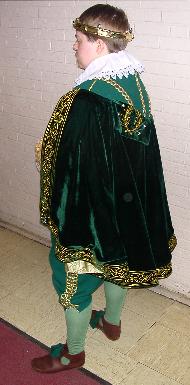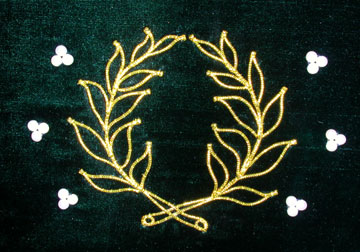|
 |
|
Baron Jehan du Lac’s Laurel Cloak The pattern of the body of the cloak is based on a short cloak in Janet Arnold’s Patterns of Fashion: The cut and construction of clothes for men and women c1500-1620, fig 251. The embroidery pattern was reproduced from Moretto Da Brescia’s ”Portrait of a Young Man”€¯ circa 1542, found in Paintings in the National Gallery, London page 249. The cloak is constructed of a 100% silk velvet, with a black medium weight wool twill interlining to give it stability and has an inner lining of black silk satin. |
|
|
||||||||||||||||||||||||||||||||
|
The patterns used were drawn onto paper and then pierced repeatedly with an awl. They were pinned into place on the velvet and then pounced with chalk dust which left a pattern of dots on the velvet. The pattern was then painted on the velvet by connecting the dots with a solution of chalkdust and water. Once the gold cord was applied, the chalk dust was beaten and brushed away. |
|
|
||||||||||||||||||||||||||||||||
|
Master Luke Knowlon’s cloak: A cloak for Master Luke Knowlton, upon receiving his court baroncy. This was a private commision from Baron Jehan du Lac. The cloak is made of 100% silk velvet with an antique gold €¯silk brocade lining and decorated with couched gold cord. The pattern of the body of the cloak is also based on the short cloak in Janet Arnold’s Patterns of Fashion: The cut and construction of clothes for men and women c1500-1620, fig 251. The pattern for the couched cord was taken from an example of couched gold cord in Janet Arnold’s Patterns of Fashion: The cut and construction of clothes for men and women c1500-1620, fig 282.. |
 |
|||||||||||||||||||
 |
|||||||||||||||||||
|
Detail on the couched gold cord work, real pearls were used to decorate around the laurel wreath on the collar. |
|||||||||||||||||||
 |
|||||||||||||||||||
 |
|||||||||||||||||||
 |
|||||||||||||||||||
|
The inspiration for the cloak was found in this pattern of couched gold cord. |
|||||||||||||||||||
|
Eleanor of Toledo Dress: Gisella herself in a dress she made from the Eleanor of Toledo pattern in Janet Arnold’s Patterns of Fashion. |
|||||||||||||||||||
 |
|||||||||||||||||||
|
Effigy Corset: This is the latest in a number of caned corsets that Gisella has been working on. Working with Drea Leed’s writeup on the effigy corset and corset details from Janet Arnold’s Patterns of Fashion, Gisella created the above corset. She has taught the construction of this corset and how to get it to fit properly at several events. As an experiment, Gisella has been using 4mm rattan caning instead of straw, to see how it compares in bending and support. |
|||||||||||||||||||
 |
|||||||||||||||||||
 |
|||||||||||||||||||



















